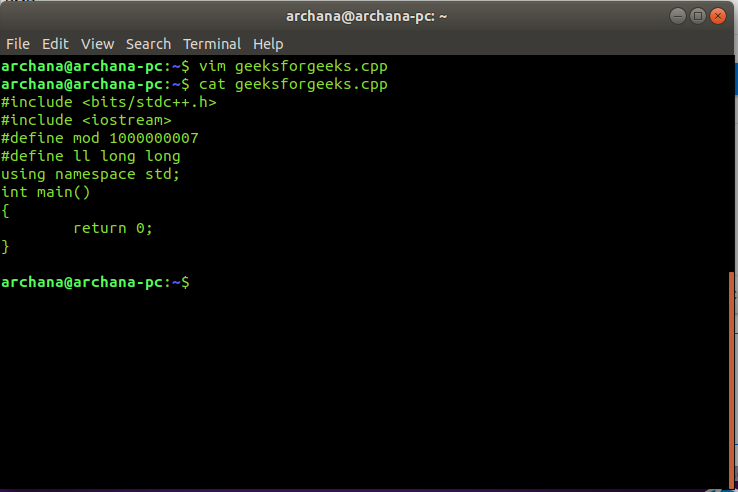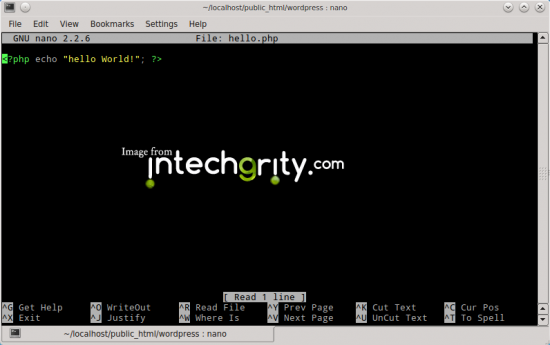
- #HOW TO EDIT TEXT FILE IN TERMINAL NANO HOW TO#
- #HOW TO EDIT TEXT FILE IN TERMINAL NANO INSTALL#
- #HOW TO EDIT TEXT FILE IN TERMINAL NANO UPDATE#
"ctrl + a" to move to the start of the current line Move your cursor using the arrow keys or by using this set of keys: You can exclude "-nw" if you want it to open in a new window. In this command, "-nw" means no window and causes the editor to open in the terminal rather than in a new window. Use the command "emacs -nw " to open a file on emacs.
#HOW TO EDIT TEXT FILE IN TERMINAL NANO INSTALL#
To install emacs, open the terminal using the keys "ctrl + alt + t" and use the command "sudo apt-get install emacs." Enter your administrative password when prompted, and press the "y" key to confirm the installation process. Install EmacsĮmacs is a commonly used editor, but it's not usually pre-installed on Linux systems. It can be more challenging than other command line editors, but once you understand it, you can gain access to many helpful functions.
#HOW TO EDIT TEXT FILE IN TERMINAL NANO HOW TO#
Related: Linux Admin Interview Questions and Example Answers How to edit files with emacs command line editorĮmacs is a versatile command line editor for Linux systems. If you want to be sure you saved changes, use the command "cat. Once you save a file, you can use the "ctrl + x" keys to exit the editor. It only requires pressing the "ctrl + O" keys. Like many other operations in nano, saving a file is easy. Next, you can add new text, delete text or edit existing text. Move your cursor to the desired position using the arrow keys. One helpful feature of nano is that the text editor displays the keys for basic operations at the bottom of the screen, such as "^\" for replacing text and "^J" for justifying text. Another way to open a file in nano is by typing the "nano" command followed by the file's path. This also creates a file of that name if the file doesn't already exist.

You can navigate to the directory where you stored your file using the command "cd directory name" and then entering the command "nano. There are two ways to open files in nano.
#HOW TO EDIT TEXT FILE IN TERMINAL NANO UPDATE#
You can check if you have nano by using the command "nano -version" and, if necessary, update it using the command "sudo apt update." If you need to install nano, use the command "sudo apt install nano". Many Linux systems have nano pre-installed, but if you don't have it, you can easily install it. Here are steps you can follow to edit a file with the nano command line editor: 1. This is great for beginners or for programmers who only need to perform simple actions, as it's often easier to use than a command line editor such as Vi. Nano is another popular command line editor for Linux systems. Related: Top 35 Linux Interview Questions in 2021 (With Example Answers and Tips) How to edit files with nano command line editor You can also exit without saving by pressing the ":q!" keys or save the file with a new title by using "command :w. To accomplish this, press the "ESC" key follow by the ":wq!" keys. With the file edited, the next step is to save and exit. Here are a few key commands that can help you with editing text in insert mode: You can also delete text or edit existing text. Place the cursor where you want to edit, and enter new text. Move the cursor by using arrow keys or by using this set of keys: Once you're in insert mode, you can make the desired edits to the file. Press the "ESC" key followed by the "i" key to switch over to insert mode. To edit a file, you might want to use insert mode.

The Vi command line editor can operate in many different modes, such as normal mode, command mode and line mode. Related: How To Become a Linux Administrator 2. Remember that file names in Linux are case sensitive. txt," with " being the title of your file without brackets. If you haven't created a file yet, you can do so with the "cat" command, which looks like "cat > name of file.txt". Here are steps you can follow to edit a file with the Vi command line editor: 1. It can be a complex editor to use but provides extensive functionality. The Vi editor is a widely used command line editor for Linux systems, and it's usually pre-installed.

How to edit files with the Vi command line editor In this article, we explain how to edit files in Linux using three different command line editors. If you work with Linux, it can be helpful to know how to edit files in Linux systems. Most usable items within Linux are either a file or a process, so people who use Linux interact with files frequently. Linux is an open source operating system used by many programmers, as it's highly secure, contains a plethora of programs and applications and allows for modifications by anyone.


 0 kommentar(er)
0 kommentar(er)
